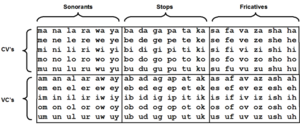The syllable database
From CNBH Acoustic Scale Wiki
The syllable database is the database of speech syllables that was developed at the Centre for the Neural Basis of Hearing at the University of Cambridge, UK.
An example of a sequence of syllables
|
Outline
The syllable database is a database of speech sounds that can be used as stimuli in psychoacoustic experiments. It provides the experimenter with a large set of speech sounds that are controlled over a number of parameters. A full description is provided in Ives et al. (2005).
How it is generated
The syllable database contains 180 original syllables but thousands more which have been resynthesized with many different combinations of GPR and VTL. The syllables were divided into 6 groups: three consonant-vowel (CV) groups and three vowel-consonant (VC) groups. Within the CV and VC categories, the groups were distinguished by consonant category: sonorants, stops, and fricatives. The full set of syllables is shown in Table I above. The syllables were recorded from one speaker in a quiet room with a Shure SM58-LCE microphone. The microphone was held approximately 5 cm from the lips to ensure a high signal to noise ratio and to minimize the effect of reverberation. A high-quality PC sound card (Sound Blaster Audigy II, Creative Labs.) was used with 16-bit quantization and a sampling frequency of 48 kHz. The syllables were normalized by setting the RMS value in the region of the vowel to a common value so that they were all perceived to have about the same loudness. We also wanted to ensure that, when any combination of the syllables was played in a sequence, they would be perceived to proceed at a regular pace; an irregular sequence of syllables causes an unwanted distraction. Accordingly, the positions of the syllables within their files were adjusted so that their perceptual-centers (P-centers) all occurred at the same time relative to file onset. The algorithm for finding the P-centers was based on procedures described by Marcus (1981) and Scott (1993), and it focuses on vowel onsets. Vowel onset time was taken to be the time at which the syllable first rises to 50 % of its maximum value over the frequency range of 300-3000 Hz. To optimize the estimation of vowel onset time, the syllable was filtered with a gammatone filterbank (Patterson et al., 1992) having thirty channels spaced quasi-logarithmically over the frequency range of 300-3000 Hz. The thirty channels were sorted in descending order based on their maximum output value and the ten highest were selected. The Hilbert envelope was calculated for these ten channels and, for each, the time at which the level first rose to 50 % of the maximum was determined; the vowel onset time was taken to be the mean of these ten time values. The P-centre was determined from the vowel onset time and the duration of the signal as described by Marcus (1981). The P-center adjustment was achieved by the simple expedient of inserting silence before and/or after the sound. After P-center correction the length of each syllable, including the silence, was 683 ms.
References
References
- Ives, D.T., Smith, D.R.R. and Patterson, R.D. (2005). “Discrimination of speaker size from syllable phrases.” J. Acoust. Soc. Am., 118, p.3816-3822. [1]
